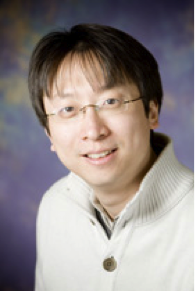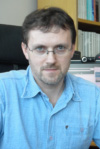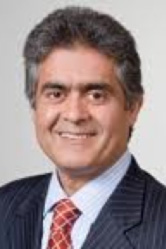Invited Talks
Home > Program > Invited Talks
- Yi Ma (MSRA, China / UIUC, USA)
- Krystian Mikolajczyk (University of Surrey, UK)
- Nassir Navab (Technical University of Munich, Germany)
- Jin Hyung Kim (KAIST, Korea)
Invited Talks
Tuesday November 13, 2012, 09:00-09:40
Main Hall, Invited Talk Session-I TuAT1
|
Abstract: In this talk, we will discuss a new class of models and techniques that can effectively model and extract rich low-dimensional structures in high-dimensional data such as images and videos, despite nonlinear transformation, gross corruption, or severely compressed measurements. This work leverages recent advancements in convex optimization for recovering low-rank or sparse signals that provide both strong theoretical guarantees and efficient and scalable algorithms for solving such high-dimensional combinatorial problems. These results and tools actually generalize to a large family of low-complexity structures whose associated (convex) regularizers are decomposable. We illustrate how these new mathematical models and tools could bring disruptive changes to solutions to many challenging tasks in computer vision, image processing, and pattern recognition. We will also illustrate some emerging applications of these tools to other data types such as web documents, image tags, microarray data, audio/music analysis, and graphical models.
This is joint work with John Wright of Columbia, Emmanuel Candes of Stanford, Zhouchen Lin of Peking University, and my students Zhengdong Zhang, Xiao Liang of Tsinghua University, Arvind Ganesh, Zihan Zhou, Kerui Min and Hossein Mobahi of UIUC.
Biography: Yi Ma is a Principal Researcher and the Research Manager of the Visual Computing group at Microsoft Research Asia in Beijing since January 2009. Before that he was a professor at the Electrical & Computer Engineering Department of the University of Illinois at Urbana-Champaign. His main research interest is in computer vision, high-dimensional data analysis, and systems theory. He is the first author of the popular vision textbook “An Invitation to 3-D Vision," published by Springer in 2003. Yi Ma received his Bachelors’ degree in Automation and Applied Mathematics from Tsinghua University (Beijing, China) in 1995, a Master of Science degree in EECS in 1997, a Master of Arts degree in Mathematics in 2000, and a PhD degree in EECS in 2000, all from the University of California at Berkeley. Yi Ma received the David Marr Best Paper Prize at the International Conference on Computer Vision 1999, the Longuet-Higgins Best Paper Prize at the European Conference on Computer Vision 2004, and the Sang Uk Lee Best Student Paper Award with his students at the Asian Conference on Computer Vision in 2009. He also received the CAREER Award from the National Science Foundation in 2004 and the Young Investigator Award from the Office of Naval Research in 2005. He was an associate editor of IEEE Transactions on Pattern Analysis and Machine Intelligence (PAMI) from 2007 to 2011. He is currently an associate editor of the International Journal of Computer Vision (IJCV), the IMA journal on Information and Inference, SIAM journal on Imaging Sciences, and IEEE transactions on Information Theory. He has served as the chief guest editor for special issues for the Proceedings of IEEE and the IEEE Signal Processing Magazine. He will also serve as Program Chair for ICCV 2013 and General Chair for ICCV 2015. He is a senior member of IEEE and a member of ACM, SIAM, and ASEE.
Invited Talks
Tuesday November 13, 2012, 14:30-15:10
Main Hall, Invited Talk Session-II TuCT1
|
Abstract: Much research in computer vision and pattern recognition is focused on developing new approaches for popular bags of visual words models such as interest point detectors, descriptors, spatio-temporal representations, codebook and coding schemes as well as classifiers. In this talk, I will present our recent projects on image and video recognition where interest points and local descriptors play a crucial role. I will present our recent approaches to extract and represent spatio-temporal characteristics of local features, in particular, their appearance-motion history captured from a moving camera. I will also discuss the machine learning techniques we apply to improve discriminative capabilities of local descriptors or fuse information from various feature channels to maximize recognition performance. These, as well as the process of designing the recognition approach to meet the application requirements will be discussed in the context of several applications including object detection from UAVs, sport recognition, mood classification and animal identification.
Biography: Dr Krystian Mikolajczyk (PI) is an associate professor in the Centre for Vision Speech and Signal Processing at the University of Surrey. He completed his PhD degree in 2002 at the Institute National Polytechnique de Grenoble, France. He then worked as a research officer in INRIA, University of Oxford and Technical University of Darmstadt (Germany), before joining the University of Surrey in 2005. His main area of expertise is in image and video recognition, in particular in problems related to image representation and machine learning. He participated in a number of EU and UK projects all in the area of image and video annotation and retrieval. Dr Mikolajczyk has more than 60 publications in top-tier forums such as ICCV, ECCV, CVPR as well as journal articles in PAMI, IJCV, CVIU, JMLR etc. He has served in various roles at major international conferences (e.g. ICCV, CVPR, ICPR, NIPS), co-chairing British Machine Vision Conference 2012 and IEEE International Conference on Advanced Video and Signal-Based Surveillance 2013.
Invited Talks
Wednesday November 14, 2012, 09:00-09:40
Main Hall, Invited Talk Session-III WeAT1
Technical University of Munich, Germany |
Abstract: In this talk, I first focus on the needs for development of novel techniques for patient and process specific intra-operative imaging and visualization and present some of our latest results as exemplary cases. As novel intra-operative and multi-modality imaging techniques provide the surgical crew with rich co-registered information, their appropriate visualization and their integration into surgical workflow, their validation and finally their full deployment are becoming active subjects of research in our community. Pattern recognition, computer vision and machine learning techniques are further developed to help recovering and modeling surgical procedures and providing innovative solutions. I will in particular trace the Freehand SPECT and Camera Augmented Mobile C-arm (CAMC) from the early development of research ideas within our multi-disciplinary research laboratories to their deployment in different surgical suites. I will finally show how the 'real world laboratories' at our university hospitals demonstrate their efficiency through the smooth path they pave for bringing advance imaging and visualization techniques into the surgical theatres.
Biography: Nassir Navab is a full professor and director of the institute for Computer Aided Medical Procedures (CAMP: http://campar.in.tum.de) at Technical University of Munich (TUM) with a secondary faculty appointment at its Medical School. He is also acting as Chief Scientific Officer for SurgicEye GmbH (http://www.surgiceye.com). In November 2006, he was elected as a member of board of directors of MICCAI society severing until February 2011. He has served on the Steering Committee of the IEEE Symposium on Mixed and Augmented Reality between 2001 and 2008. He is the author of hundreds of peer reviewed scientific papers and over 60 US and international patents. He is the associated editor of several scientific journals including IEEE TMI and Medical Image Analysis and Computer Vision Applications. He is the general chair for IPCAI 2012, program chair for MICCAI 2010, MICCAI 2013 and general chair for MICCAI 2015. He has received Siemens Inventor of the Year award in 2001. He also received the SMIT technology award in 2010 for his inventive contributions to Camera Augmented Mobile C-arm and Freehand SPECT technologies; he is the senior author of many awarded papers in prestigious conferences including IEEE FG 2011, MICCAI 2007, 2009 and 2010, VOEC-ICCV 2009, AMDO 2009, BMVC 2009, IPMI 2007 and IEEE ISMAR 2005.
Invited Talks
Thursday November 15, 2012, 09:00-09:40
Main Hall, Invited Talk Session-IV ThAT1
KAIST, Korea |
Abstract: Three KAIST approaches for scene text recognition will be presented in this talk: color-based, edge-based, and part-based approaches. Although features of color, edge and part-relationship are utilized in all of the three approaches, there are differences on the main focus in each of these approaches. The color-based approach focuses on image segmentation mainly based on color, while the edge-based approach focuses on edge following to extract text objects. The part-based approach is an attempt to directly pin point existence of character parts in image. Each of the three approaches has merits and demerits. The text extraction results of the three approaches will be shown on some representative images known 'difficult' in the community. So, one may feel how the approaches will behave in other difficult images.
Biography: Prof. Kim, Jin Hyung received BS degree in engineering at Seoul National University, MS degree in systems engineering and PhD degree in computer science, both at UCLA. He worked at Korea Institute of Science and Technology, Hughes Research Laboratories before joining the faculty of KAIST Computer Science Department in 1985. At KAIST, he headed the department, Center for Artificial Intelligence Research, and Software Graduate School. On leave from KAIST, he worked at IBM Watson Research Center, Samsung SDS, and Korean R&D Information Center. He is a fellow of Int’l Association of Pattern Recognition, Korea Academy of Science and Technology, National Academy of Engineering of Korea. He served as the president of Korea Information Science Society. He received order of service merit, President’s Award, Internet Award from Korean government.





 Pursuit of Low-dimensional Structures
Pursuit of Low-dimensional Structures  Interest Points Detectors and Descriptors
Interest Points Detectors and Descriptors  Patient and Process Specific Imaging and
Patient and Process Specific Imaging and  Three Approaches of Scene Text Recognition:
Three Approaches of Scene Text Recognition: 
